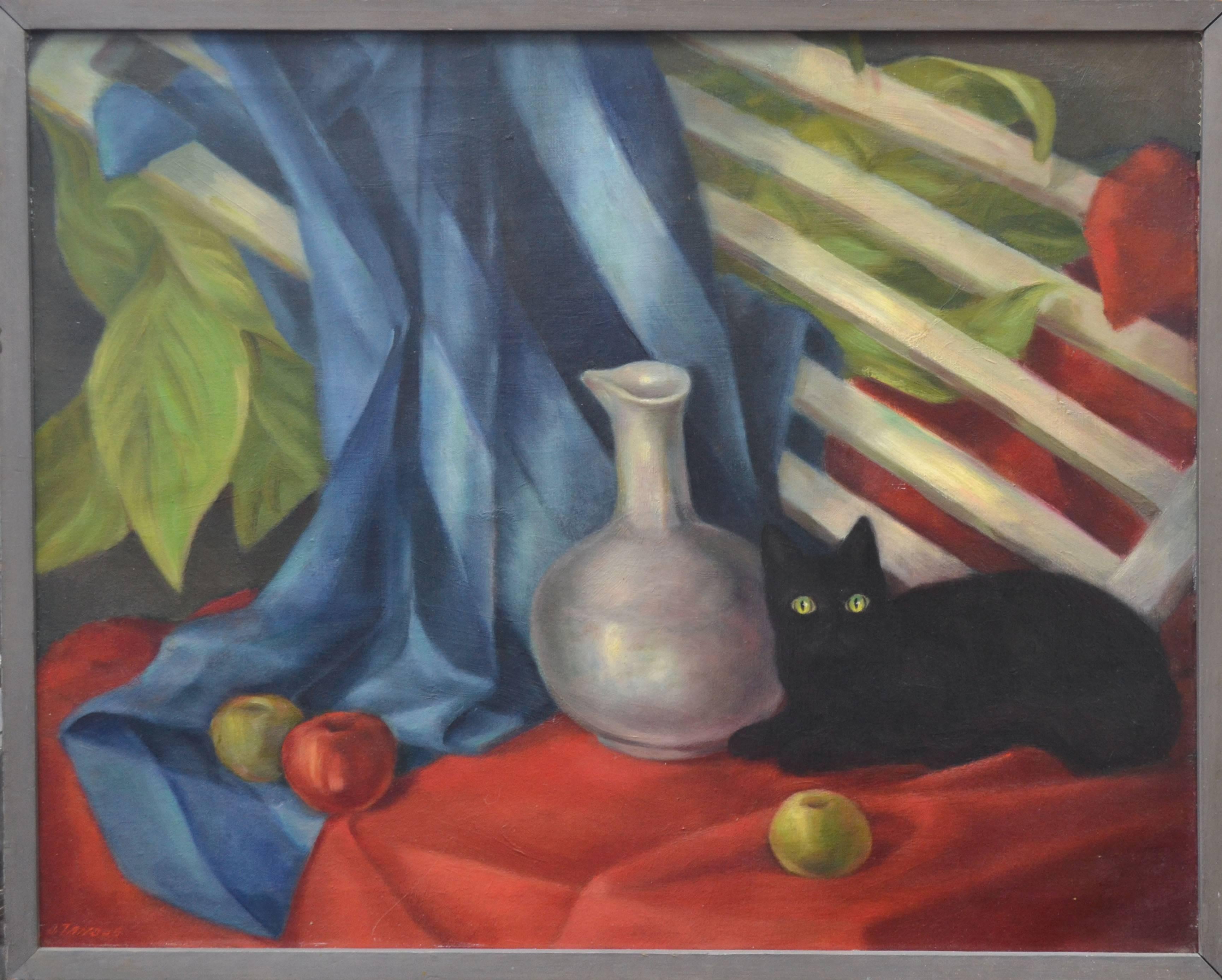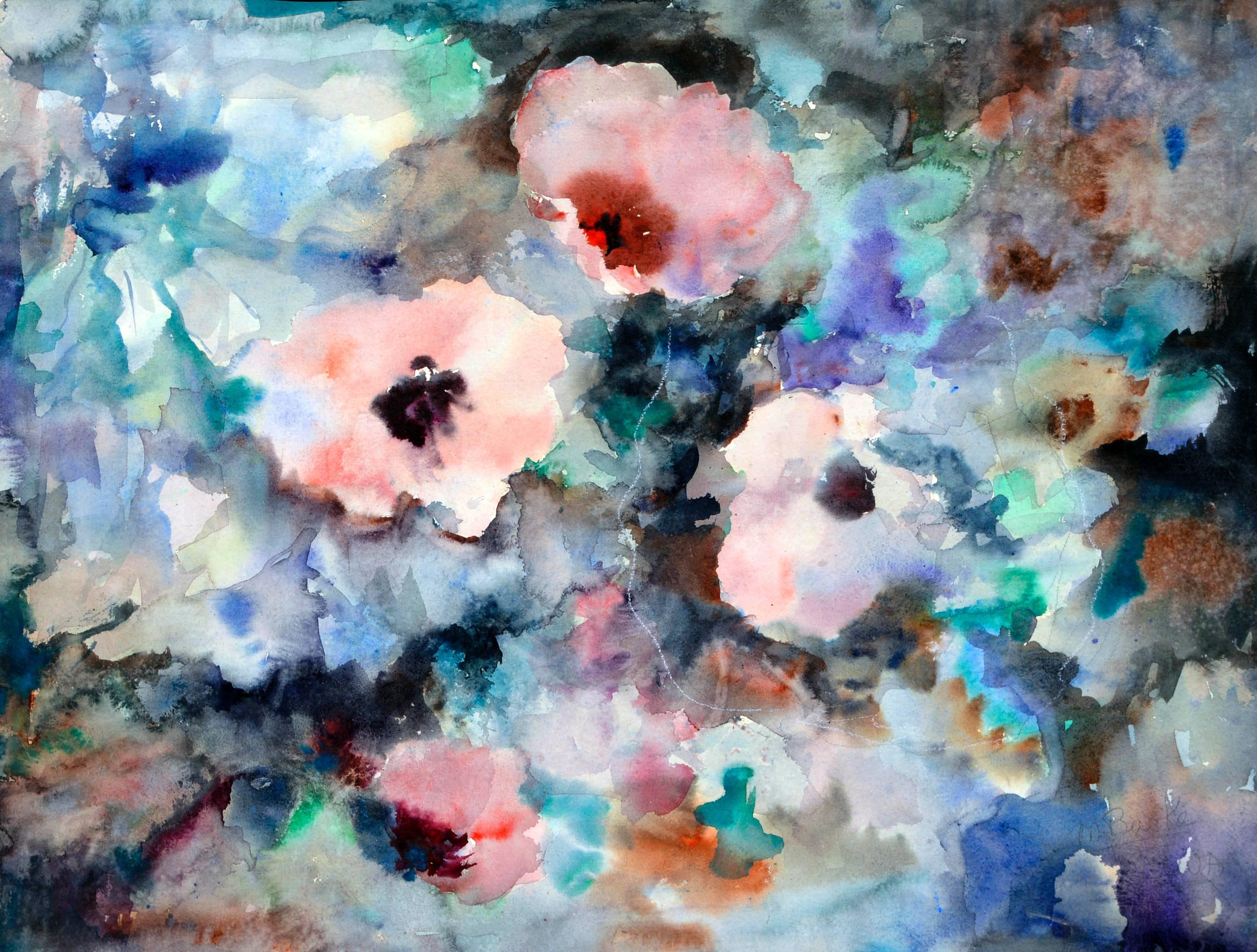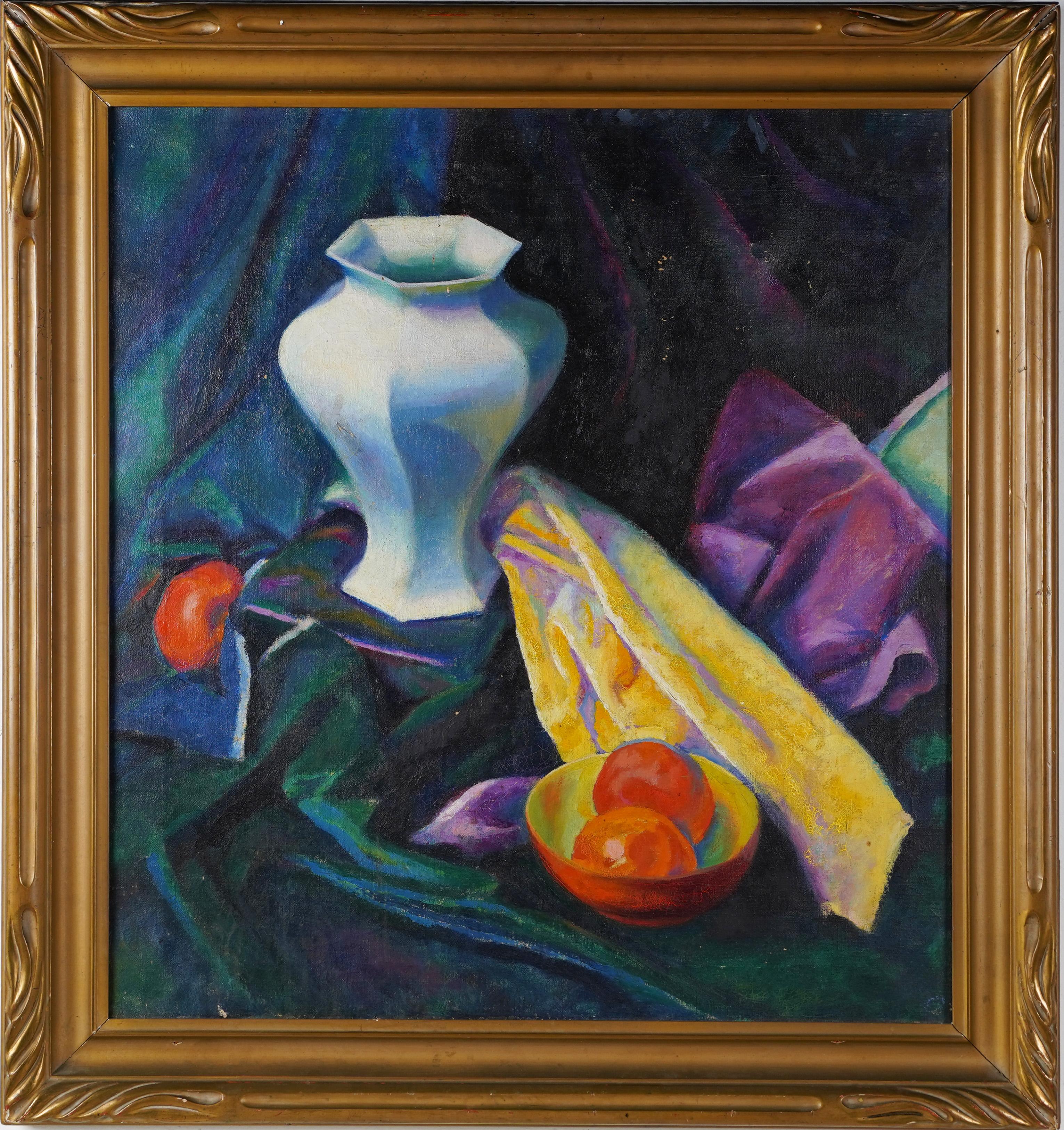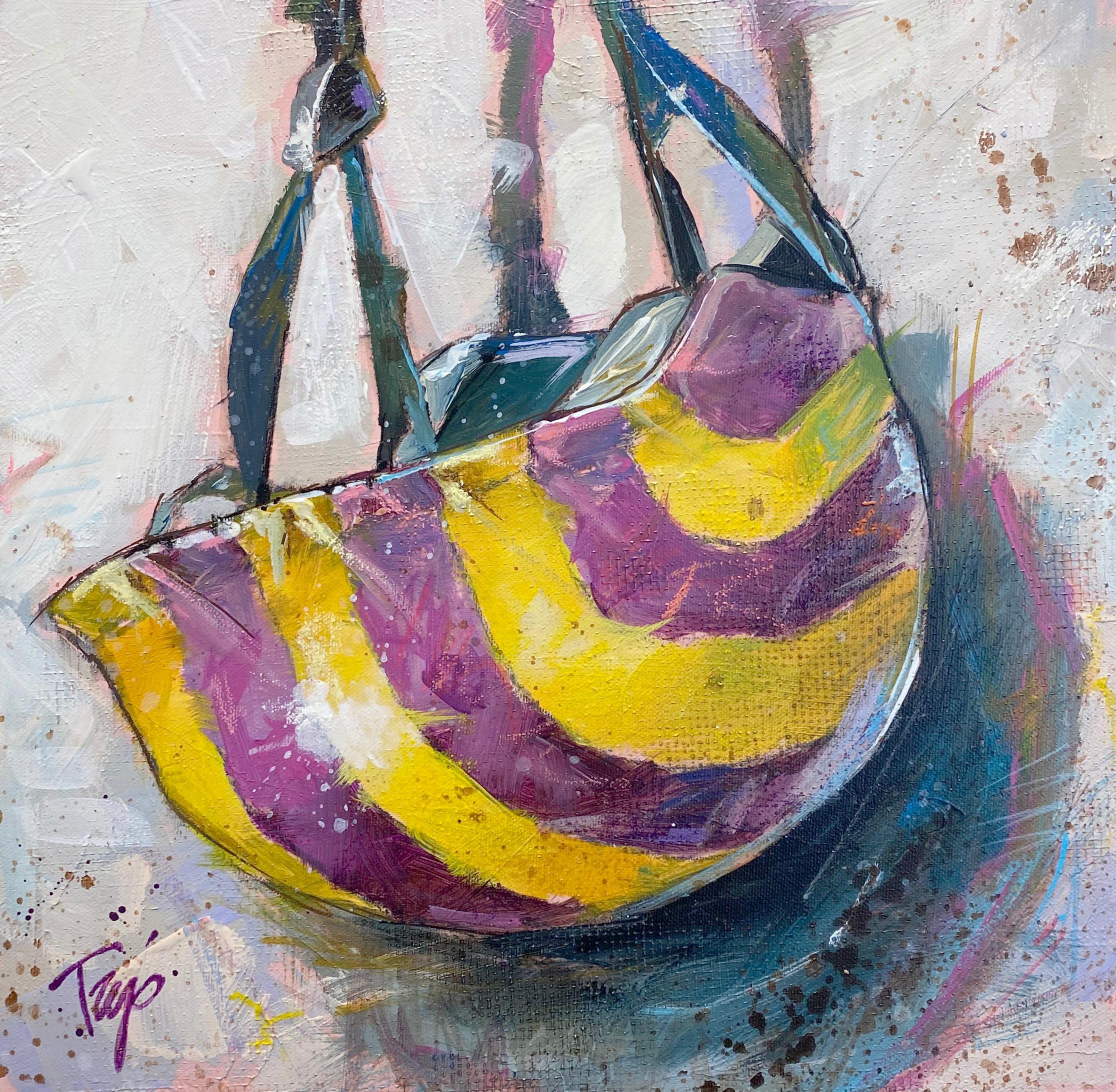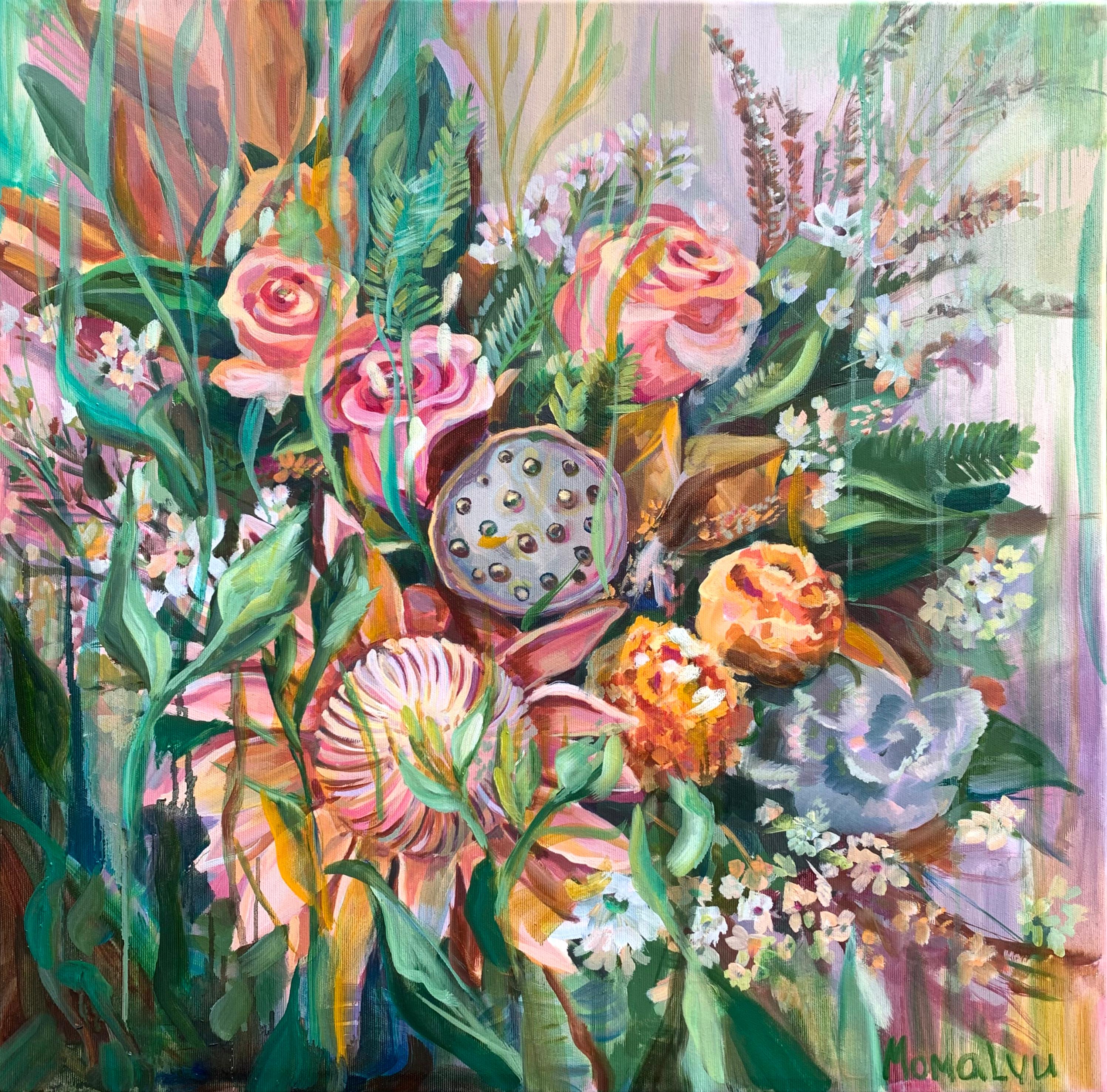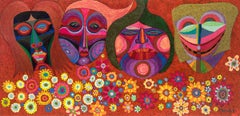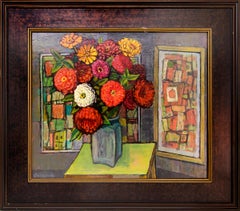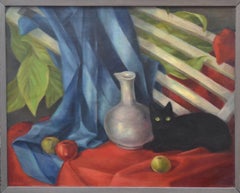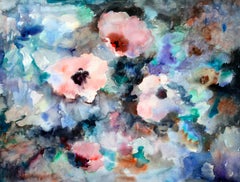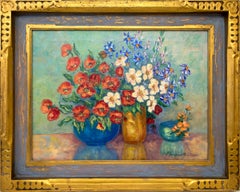
Still Life Painting with Poppies and Wildflowers in Red, White, Blue and Orange
View Similar Items
Video Loading
Want more images or videos?
Request additional images or videos from the seller
1 of 16
Florence Ann MorrisStill Life Painting with Poppies and Wildflowers in Red, White, Blue and Orangeearly 20th century
early 20th century
About the Item
- Creator:Florence Ann Morris (1876 - 1947, American)
- Creation Year:early 20th century
- Dimensions:Height: 24.5 in (62.23 cm)Width: 30.75 in (78.11 cm)Depth: 2.5 in (6.35 cm)
- Medium:
- Movement & Style:
- Period:
- Condition:
- Gallery Location:Denver, CO
- Reference Number:Seller: 258631stDibs: LU27310341672
About the Seller
5.0
Platinum Seller
These expertly vetted sellers are 1stDibs' most experienced sellers and are rated highest by our customers.
Established in 1979
1stDibs seller since 2013
265 sales on 1stDibs
Typical response time: 3 hours
More From This SellerView All
- Masks And Flowers, Semi Abstract Vintage 1984 Painting, Red Yellow Green PinkBy Edward MarecakLocated in Denver, COMasks And Flowers, vintage original 1984 oil painting on board by Edward Marecak (1919-1993), semi abstract, cubist style painting of tribal mas...Category
1980s Abstract Abstract Paintings
MaterialsOil, Board
- Still Life with Masks, Vintage Semi-Abstract Painting, Red, Pink, Yellow, GreenBy Edward MarecakLocated in Denver, CO"Still Life with Masks", vintage original semi-abstract painting by 20th century Denver artist, Edward Marecak (1919-1993) from 1983. Oil Paint on board with a mid-century modern fe...Category
1980s American Modern Abstract Paintings
MaterialsOil, Board
- American Modernist Abstract Still Life Painting with Zinnia Flowers, Red OrangeLocated in Denver, COOil on board painting by Paul Kauvar Smith (1893-1977) of a still life of flowers on a table in an interior scene with a mirror in the background. American Modernist still life painting with zinnias and abstract paintings in an artists studio. Presented framed, outer dimensions measure 27 ⅝ x 31 ¾ x 1 ⅛ inches. Image size is 19 ½ x 23 ½ inches. Painting is clean and in very good vintage condition - please contact us for a detailed condition report. Provenance: Private collection, Denver, Colorado Expedited and international shipping is available - please contact us for a quote. About the Artist: In 1915, Paul Kauver Smith studied commercial art and design at the St. Louis School of Fine Art for two years. His studies were interrupted by World War I during which he served as a corporal in the U.S. Army. After the war he returned to the School of Fine Art and also studied at the Washington University School of Fine Arts in St. Louis with Fred G. Carpenter, himself a student of Jean-Paul Laurens at the Colarossi Academy in Paris. Carpenter was known as a marvelous colorist who "thought every inch of a painting should be fascinating…and should be as interesting close up as from a distance." His approach is reflected in many of Smith’s paintings, both representational and abstract in style, done later in Colorado. In 1921, Smith relocated to Denver where he studied for two years at the Denver Academy of Fine and Applied Arts, formerly located in Brinton Terrace on 18th Street in Denver’s Capitol Hill neighborhood. His teacher was John E. Thompson, another important influence as a pioneer of modernism in Denver. The Academy hired Smith as an instructor in 1923 and that same year the Denver Art Museum included his work for the first time in its 29th annual juried exhibition. He later had two solo shows at the museum, which added his work to its Anne Evans Collection. In 1959 the museum reproduced Houses at Victor, for its Western Heritage Exhibition catalog. During the year of 1928 he witnessed the Articles of Incorporation of the Denver Artists Guild, comprising most of the city’s professional artists. He also belonged to the American Artists Professional League, also organized in 1928 by fifteen members of the Salmagundi Club in New York to protect artists’ interest and promote traditional American art. He was one of some two dozen Colorado artists designated to participate in the Public Works of Art Program (PWAP, 1933-34), the first federally-sponsored program for artists during the Great Depression. Around 1928 Smith became the "Hermit of Stuart Street," and remained a life-long bachelor. One painting, View from My Window, depicts his immediate neighborhood. Living for more than thirty years at 1039 Stuart Street in West Denver, he gave up creature comforts that most people take for granted to have the freedom to devote his life to the pursuit of art. In the first twenty-five years of his career, his paintings focused on the Colorado landscape and its mining towns with their decaying buildings as relics of the past. His piece, Miner’s House at Victor, Colorado illustrates the description of his work in this genre as described by Denver artist and art writer, Arneill Downs, "The jewel-like shapes and colors the artist uses gives the most decrepit objects style. The decaying buildings of ghost towns, grouped together on canvas, glow like a patchwork quilt." Smith described his technique as "I start lean and finish fat." He worked first with turpentine as a medium and ended up with pure pigment put on with a palette knife. In addition to Colorado scenes...Category
20th Century Abstract Still-life Paintings
MaterialsOil, Board
$3,935 Sale Price25% Off - Still Life with Pink Roses, Framed Interior Oil Painting with Pink and OrangeBy David SpivakLocated in Denver, COUntitled (Still Life with Pink Roses) is an oil on canvas painting by David Spivak (1893-1932) . Presented in a custom gold frame, outer dimensions measure 19 ⅞ x 24 x 1 ¼ inches. Image size is 12 x 16 inches. Painting is clean and in very good vintage condition - please contact us for a complete condition report. Provenance: Private Collection, Denver, Colorado Expedited and international shipping is available - please contact us for a quote. About the Artist: Born in Philadelphia in 1893, David and his family moved to Denver in 1895 due to his mother’s ill health. He attended elementary and high school in Denver, and was briefly enrolled at the University of Denver, where his mother taught Russian. He was drawn to art at a young age, however the University of Denver did not offer a degree program in fine art, and art education in the Denver area was lacking. Spivak’s father, Dr. Charles Spivak, prominent Denver physician and founder of the Jewish Consumptives Relief Society, was concerned about his son’s career choice, hoping David would instead follow in his footsteps. David’s mother, however, recognized her son’s artistic talent and felt it needed nurturing. In 1912, Spivak moved to Chicago to attend the Chicago Art Institute where he worked under John Morton and Wellington Reynolds (1865 – 1949). After a two-year stint in Chicago, Spivak spent 3 years in New York attending the Arts Students League where he studied under Robert Henri, a prominent Ashcan School artist. Between 1914 and 1917, Spivak mostly painted portraiture, and Henri’s artistic influence can be seen in Spivak’s work during this period. Spivak was drafted into the Army in 1918 because of World War I. He spent a year stationed at Kelly Field in San Antonio, Texas. In 1919, he moved back to Denver in and began working as an artist. His dedication to art extended beyond art making into education. He taught at various high schools throughout Denver, as well as the Denver Academy of Applied Arts, the Denver Art Institute, and the Chappell School of Art. Spivak was also a central figure in the art community, helping to develop the Denver Art Museum, as a founding member, along with Dean Babcock and Albert Bancroft, of the Denver Artists’ Guild in 1928 (where he served as president at the time of his death), and as the head of fine art exhibits at the Colorado State Fair. He believed that bringing art into the lives of all people, regardless of status or class, was paramount. In his short life, Spivak was quite prolific, producing over 300 paintings between 1914 and 1932. He excelled in landscape painting and portraiture, and his style was rooted in impressionism. Spivak’s contemporaries who also painted in an impressionistic manner include Robert Graham, Frank Vavra...Category
20th Century Impressionist Interior Paintings
MaterialsOil
- Springtime, 1960s Semi Abstract Modernist Mountain Landscape Tempera PaintingBy Ethel MagafanLocated in Denver, CO"Springtime" is an original tempera on board painting of a Colorado mountain landscape painting by Ethel Magafan circa 1960. Abstracted mountain landscape with trees, painted in colors of green, purple, golden yellow, red, orange, blue, black and white. Presented in a custom hardwood frame, outer dimensions measure 23 ¼ x 50 x 2 inches. Image size is 30 x 48 inches. Provenance: Private collection, Maine Acquired in the early 1960s, by descent through the family to the present owner About the Artist: Jenne and Ethel Magafan were identical twins, born in Chicago to a Greek immigrant father and a Polish mother. Due to health concerns about their father, the family moved to Colorado, living first in Colorado Springs and then in Denver. He was a proud supporter of their artistic ambitions but died suddenly 1932, a heavy blow to both of them. They attended East High School in Denver, where they found a mentor in their art teacher Helen Perry. She had studied at the Art Institute of Chicago but had later abandoned a career as an artist, making her all the more determined to help the Magafan twins succeed artistically. While still in high school, the twins impressed artist Frank Mechau, and Helen Perry paid for their lessons with him. He subsequently invited them to apprentice with him at his Redstone studio. In 1936, Jenne won the Carter Memorial Art Scholarship and shared it with her sister so that they both could attend the Broadmoor Art Academy in Colorado Springs. Once they ran out of money, Mechau, now teaching there, hired them as assistants. Through their involvement at the Academy, the twins entered into careers as muralists, working at first with Mechau and then with Peppino Mangravite. From 1937 to 1943, Ethel was commissioned to paint her first of seven government sponsored murals. Located in the US Post Office in Auburn, Nebraska, this commission made Ethel (at age 26) the youngest artist in America to receive such an honor. Denver Art Museum director Donald J. Bear once commented that “[Ethel and Jenne's] study of local detail makes them appear as little Bruegels of ranch genre – natural and unforced.” As mural painting commissions diminished, Ethel began to do more easel painting for which she used a palette knife and tempera paints to great effect. After settling in California for five years, the twins permanently relocated to Woodstock, New York in 1945, where the sisters lived apart for the first time. Ethel developed an increasing focus within her work, particularly for horses and abstract landscapes. She met fellow artist Bruce Currie...Category
Mid-20th Century American Impressionist Abstract Paintings
MaterialsTempera, Board
- 1940 Modernist Still Life with Flowers, Framed Floral Oil Painting, Red YellowBy John Edward ThompsonLocated in Denver, COAn original modernist still life oil painting by John E. Thompson (1882-1945), table is draped in red cloth and flowers in vase are red, yellow, blue/purple and white with green stem...Category
1940s American Modern Interior Paintings
MaterialsOil, Canvas
You May Also Like
- Mid Century Black Cat and Vase Still LifeBy Joseph TanousLocated in Soquel, CACharming mid century still life of fruit, vase and black cat by Monterey artist Joseph Tanous (American, b. 1925), c. 1940-50. Signed lower left corner. Presented in rustic painted w...Category
1940s American Impressionist Still-life Paintings
MaterialsCanvas, Oil
$1,480 Sale Price20% Off - Abstract Painting of ShellsLocated in Houston, TXSmall size watercolor image of shells. Painting is mainly blue, yellow and brown tones. Painting is framed in a painted wooden gold frame with a yellow matte. Dimensions without Fram...Category
1950s American Impressionist Still-life Paintings
MaterialsWatercolor
- Florida Flowers AbstractBy Mary BurkeLocated in Soquel, CABrilliant floral watercolor painting by Mary Burke (American, 20th Century). Signed "M. Burke - SWA" lower right. Titled "Floral" and sign...Category
1980s American Impressionist Abstract Paintings
MaterialsPaper, Watercolor
$1,200 Sale Price20% Off - Antique Exhibited American Impressionist 1921 Flower Still Life Oil PaintingLocated in Buffalo, NYAntique American impressionist still life oil painting by Kathryn Logan Luke. Oil on canvas, circa 1921. Housed in a period giltwood frame. Image size, 24L x 26H.Category
1920s Impressionist Still-life Paintings
MaterialsCanvas, Oil
- Soft Impressionist Listed Female Midwest Iowa Art Exhibited Still Life PaintingLocated in Buffalo, NYAntique American impressionist signed still life oil painting. Oil on board. Signed. Framed. Image size, 25L x 19H.Category
1930s Impressionist Still-life Paintings
MaterialsCanvas, Oil
$2,300 Sale Price20% Off - Antique American Signed Framed Impressionist Flower Still Life Oil PaintingLocated in Buffalo, NYAntique American impressionist signed still life oil painting. Oil on canvas. Signed. Framed. Image size, 20L x 24H.Category
Early 1900s Impressionist Still-life Paintings
MaterialsCanvas, Oil
$796 Sale Price20% Off
Recently Viewed
View AllMore Ways To Browse
Vintage Cowboy Painting
Antique Zuni
Vintage Wildflower
Painting Apache
Hopi Pueblo
Acoma Pueblo
Warren E Rollins
Traditional Still Lifes
Flower Still Life Oil Paintings
French Still Life Oil
Original Oil Still Life Paintings
Still Life On Board
Still Life French Oil Painting
French Oil Painting Still Life
Flowers Art Composition
Retro Still Life Oil Paintings
Painting White Flower
White Floral Art
